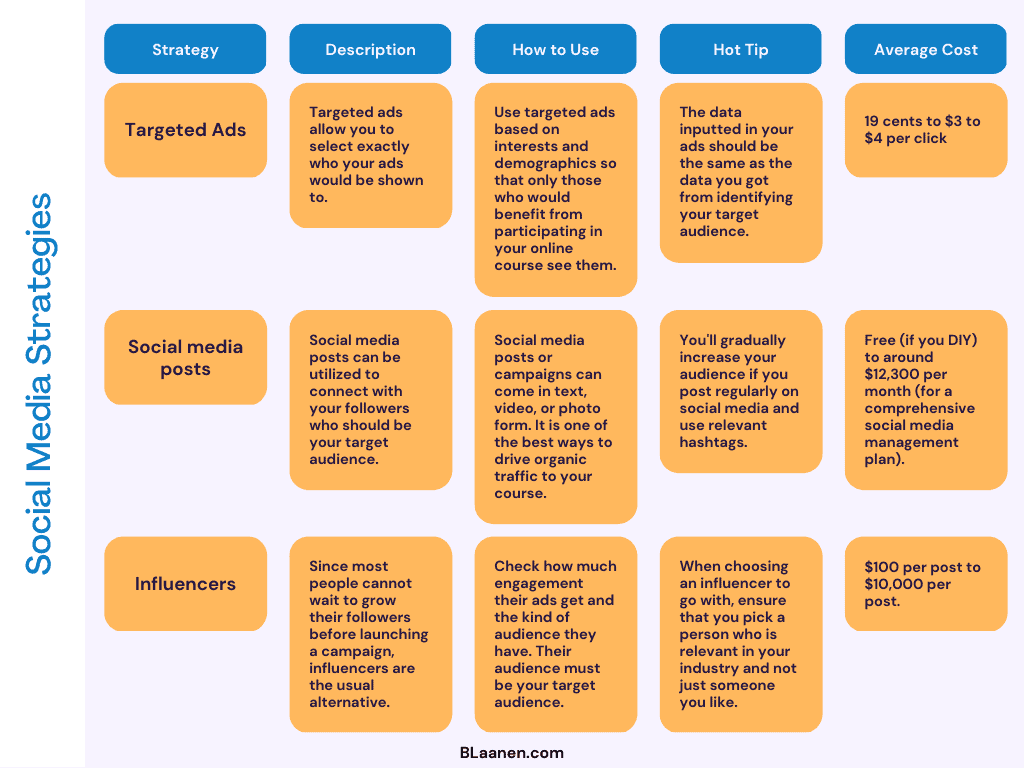Here’s a time tested fact: Having a deep understanding of how to market online courses is important if you want to record profits.
As a course developer, your true passion is creating content and watching your students learn. But you may not be as well versed or as excited about marketing your courses to potential students. Don’t worry; we’re here to help you learn how to market online courses.
It doesn’t have to be as intimidating or overwhelming as it may seem. You can create an effective marketing strategy for your online courses with the information below. You can also make sure they reach the right people.
This article will teach you how to:
- Determine your ideal student
- Pick the right platform
- Create content that resonates with your audience
- Use strategic partnerships to grow
- Promote and market your course to get more signups
Let’s get started on this journey of understanding how best to track and measure results, no matter where your learners are in the world.
Table of Contents
ToggleIdentify Your Target Audience

The first step in marketing an online learning course is identifying your target audience. All the marketing strategies you can think of rely on this one step. Your target audience is unique to your course, so consider this if you’re trying to market multiple courses.
Knowing who you are targeting and their needs will help you create a successful marketing strategy that resonates with them. I often tell my clients: “Sell your students what they want, not what you think they need!”
And that’s because, as content creators, we know what helps get our students to the next level. If only they would listen! The truth is, if we want our online course to sell, we have to connect with what students are looking for.
Clients desire
- Happiness
- Satisfaction
- Security
- Recognition
- Self-expression
- Personal growth.
Don’t forget that most people believe that money is the answer to most of these desires.
To market your online course, you must know your target audience. Of course, you’ve probably got a good idea already of who your courses are a great fit for. But let’s dig a layer deeper.
How to Research Your Target Audience To Sell Courses Online
Start by researching the demographics of your ideal customer. Consider factors such as age, gender, location, income level, occupation, education level, and more. This information can give you insight into how best to reach this group and market your online course to them.
Next, consider their interests and behaviors: What do they like? What kind of content do they engage with? Are there any topics or trends that could be used in your messaging? Understanding these elements can help you craft messages that appeal to them specifically.
Finally, consider what motivates them when taking an online course: Do they want convenience? A better job opportunity? To learn something new for fun? Identifying their motivations will help you get more familiar with your target audience.
How To Use Your Research To Sell Online Courses
Most online course creators research their target audience before creating content. This research becomes even more critical when it’s time to figure out your course marketing strategy.
Understanding your target audience before creating a marketing plan allows you to craft advertisements and content your target audience would like. This will help create more effective campaigns that resonate with the right people and drive better results when you sell online courses.
Once you’ve identified your target audience and how to advertise, it’s time to choose the best platforms to connect to them.
Choose Your Marketing Channels

With your target audience down to a pat, it’s time to decide what means you’ll use to contact them. You’ve got many options to pick from. Here are two of the most popular choices.
1. Website

A website is one of the most popular ways to market a course. Websites can host:
- Blog posts
- Landing pages
- Sales pages
- Mini-courses
- Downloadables
- Videos
- Images
- Live webinars
- Press releases
- Advertisements
Future students are more likely to visit your website before contacting you. Websites can even be used to host online classes. You can choose a course page where you tell your website, visitors/ potential students more about your course or provide snippets.
Since websites can run 24/7, seven days a week, they are an efficient and cost-effective marketing tactic. Websites can also host blogs, a great way to post content that advertises your course.
Say you have a course on dog training. A blog post about a dog you successfully trained is a great way to show people what they can get from your course.
2. Social Media

Social media is today’s most common form of marketing today. Almost everyone and their dog is on social media. It is one of the most effective ways to market your online course. There are multiple ways to market a course through this medium. Here are some of the most common routes:

Top Channels to Consider
Thinking of opting for social media strategy? Here are the top social media platforms and their advantages. Go with an option that caters to the needs and specifications of your course. If you’re offering a course delivered through videos, you’re better off opting for visual-based platforms.
YouTube
YouTube is the perfect platform to run your social media ads for online course creation. With over two billion users and counting, YouTube has a massive reach. This can help you reach new people interested in learning about your courses.
Plus, with its advanced targeting capabilities, you can ensure that your ads reach the right audience for maximum impact. The platform also offers various video formats, from full-length ads to short clips. This way, you can choose the type of content that best resonates with your target audience.
YouTube allows for analytics tracking. It gives you insight into how your campaigns are performing and where improvements can be made. YouTube is an excellent choice because it’s cost-effective and can help you reach more people with less money.
Instagram has over one billion active users, making it a great platform to market your course. It offers an immersive and engaging visual experience thanks to its image-focused approach. Instagram ads let course creators create visually stunning content and target their exact audience.
Instagram makes it easy for course creators to track the performance of their ads and make adjustments as needed. They can also measure the reach and engagement of their posts to optimize their campaigns for maximum impact.
TikTok
TikTok is an ideal platform for online course creators to run social media ads. With its unique, short-form video format, you can easily showcase the benefits of taking your course creatively and engagingly.
You can also use TikTok’s powerful targeting tools to reach potential students who are most likely interested in what you have to offer. With its highly engaged audience and low ad costs, TikTok gives you the perfect opportunity to reach potential students
With over 2 billion active users, Facebook offers a massive potential audience with diverse tastes and interests. No other platform can offer granular targeting capabilities when creating the perfect ad for your online course. You can target people with:
- Specific interests,
- Age ranges,
- Locations, etc.
This precision targeting ensures you reach the people most likely to buy your course. Facebook’s Ads Manager dashboard is easy to use and intuitive for even novice advertisers.
With everything from ad creation to monitoring performance at your fingertips, you can easily track your ad’s progress and make adjustments as needed. This saves time and money in the long run.
On Twitter, you can reach potential students quickly and easily using:
- Hashtags,
- Keywords,
- Retargeting options.
You can create highly targeted ads based on users’ interests, locations, and other demographic information.
Twitter’s analytics tools allow you to measure the performance of your campaigns and tweak them for better results. With Twitter, it’s easy to track conversions, measure ROI, and adjust ads in real time. All this makes it an ideal platform for online course creators who want to reach more students with their courses.
Making A Choice
Videos and other media content drive traffic and help course creators like you engage with potential students. Consider creating tutorial videos or Q&A sessions that showcase what makes your online course unique.
A social media platform is one of the best ways to promote video content to market a course. A social media presence also gives your existing students a place to interact with each other.
If you build a devoted audience on any of these platforms, your audience will steadily increase, allowing you to reach more people and market your course to a broader audience.
Offering Freebies as lead magnets in exchange for student emails

Once you have chosen the platforms to market your online courses, it’s time to start giving away free learning content in exchange for student emails. This process effectively builds a list of potential customers and generates interest in your courses.
Offering free content is an essential part of capturing leads for online courses. It allows you to showcase the value of your course and engage with potential students. Free content also serves as a great SEO tool, helping to boost visibility and searchability for your course in online searches.
Content such as blog posts, infographics, ebooks, or webinars can create interest and excitement about your offer. With the right strategies in place, free content offers can be an effective way to capture leads.
Another benefit of creating and offering a free resource is establishing yourself as an authority in your niche. Potential students who see that you offer quality content for free will likely trust you and invest in your paid offerings.
By giving away something of value, you will attract people who may not be able to afford your entire online course but are still interested in learning more.
After carefully preparing your freebie, you’d need to pick a medium to host or offer this freebie. The most common choice among course creators is a website that hosts their course sales page.
Many form builders will allow you to host a landing page or course sales page without a website if you do not have a website.
Ensure you keep in touch with your subscribers to market to them when new courses become available. You can keep in touch through email newsletters and SMS messages and even market special offers and discounts.
How To Promote Your Free Content
Once you create your free content, don’t forget to promote it just like you promote your course. People love getting free quality materials, so you’ll get a bite if you put your bait in front of the right audience.
Utilize social media platforms like Twitter and Facebook and paid advertising options like Google Ads or Bing Ads, depending on budget constraints.
This process will help ensure maximum reach amongst potential students who could benefit from accessing this material before making any financial commitments towards purchasing one of your courses later down the line.
How To Collect Student Emails

To collect student emails from those who download your free content, use a form builder such as MailChimp or AWeber. This process allows users to sign up using their email addresses without any required technical knowledge.
You can then add these emails to a database where you can send them updates about new courses or other offerings related to the topic at hand. This process ensures that even if someone isn’t ready now, they will still receive notifications about future opportunities from you.
Collecting emails is even more critical if you have created your first course and plan to create more courses related to the first-course topic. If people got value from your previous course or even a free email course, they’d be more likely to purchase another course from you.
Working With Partners and Influencers
Leveraging partnerships can be a great way to amplify the reach of any given piece of content. This can include:
- Featuring another expert in the field on a podcast episode
- Hosting a webinar with someone else within their network
- Cross-promoting each other’s blogs, videos, and podcast episodes.
By leveraging these partnerships, visibility for both parties can be significantly boosted. When working with influencers, ensure they create engaging content that resonates with their followers. They should encourage their followers (your target audience)to take action (e.g., sign up for a free trial).
Once you start partnering up with influencers, you must track results from each campaign to know what works and what doesn’t.
You should also utilize tools like Google Analytics or other analytics software solutions available on social media platforms. Some examples are Facebook Insights and Twitter Analytics. This will help you measure performance metrics like website visits and conversion rates.
Partnering with the right organizations and influencers can help course creators reach their target audience, drive more sales, and increase brand awareness.
Other Ways to Market Your Course

- Reddit and Pinterest: If used well, you can reach your target audience through Reddit and Pinterest posts. This is more feasible if you already have a following on these sites. If you do not, stick to using influencers that can reach your audience for you.
- Membership Sites: Membership sites offer content that viewers can access only after paying a fee. This is one of the best marketing strategies because you already know that site members are willing to pay. Get in touch with the administration and ask how you can market on their site.
- Affiliate Programs: One easy and stress-free way to market your course is to start an affiliate program. This means that you pay a percentage of the course fee to anyone who refers students to you. This will allow you to bring in revenue without going after it yourself.
- Google Ads: Google ads allow you to reach out directly to people who have already indicated an interest in what you have to offer through a Google Search. Google ads are easy to set up and understand, even if you have no prior knowledge.
Creating Engaging Content

Content is the key to successful marketing for online learning course creators. You must create content to engage potential customers and build trust in your brand
Your content must resonate with your target audience and encourage them to take action. Here are some content ideas that can be posted on various mediums.
- Visuals: Visuals are a great way to grab attention quickly and communicate complex ideas. Use visuals such as images, infographics, videos, GIFs, or illustrations to make your content more engaging and memorable.
- Videos: Videos can be used in many different ways – from product demos or tutorials to interviews with experts or customer testimonials. They’re also effective in conveying complex concepts in an easy-to-understand format.
- Webinars: A live webinar is a live event that allows you to interact directly with participants. You can answer questions and provide additional insights into topics related to your business or industry. This helps establish yourself as an authority on the subject matter. Best of all, it drives leads for your online courses through direct engagement with potential students.
- Blog Posts: Blogging is one of the most cost-effective forms of content marketing available today, it’s free. Writing blog posts on topics related to online learning will help attract visitors who may be interested in taking online courses from you later down the line. They provide valuable SEO benefits too.
- Podcast: Podcasting is becoming increasingly popular as a form of digital media consumption. It allows you to share valuable information about your industry while simultaneously building relationships with potential customers.
If you pick the right one, podcasts can be leveraged as a sales funnel. You should research successful podcasts and reach out to the owners to find out what you need to do to get featured. You could start your own podcast, which can help establish you as an authority in your field.
Search Engine Optimization (SEO)

Search engine optimization is important for online course creators because it can help them reach their target audience and increase the visibility of their courses. SEO helps course creators optimize their content to appear higher in search results. This increases organic traffic to their courses.
Course creators can use SEO techniques such as keyword research and link building to boost their rankings on search engines and maximize their exposure. This increased visibility can lead to more people discovering and enrolling in the creator’s online courses. As a result, you get greater potential revenues from those who enroll.
SEO gives online course creators a competitive edge in marketing initiatives. It can help you stand out from the crowd and ensure that potential students find you easily.
Track & Measure Results

Once all these pieces have been created and leveraged, the next step involves tracking and measuring results. If needed, this is essential to make adjustments based on performance data collected over time.
This could include anything from website traffic stats and conversion rates through email campaigns to social media engagement metrics (likes, shares, comments).
Here are 4 of the key metrics you should be tracking.
1. Website Visits
Website visits are a key metric for tracking the success of your online learning course. By monitoring how many people visit each page on your website, you can get an idea of which topics or areas they’re interested in. This information can be used to create more targeted content that appeals directly to their needs and interests.
2. Conversions
Conversions measure how successful you are at turning visitors into customers or leads. You should track conversions from all sources, including:
- Organic search traffic,
- Social media campaigns,
- Mail campaigns.
Doing so will help you identify where most of your sales come from and focus more energy there if needed.
3. Leads Generated
Leads generated refer to the number of potential customers who have expressed interest in purchasing one of your courses. They do this by signing up for a free trial or downloading a sample lesson plan. Tracking this metric will indicate how effectively different marketing strategies generate new leads for future sales opportunities.
4. Customer Retention Rate
Customer retention rate measures how successfully you keep existing customers engaged with your courses over time. Some customer retention strategies include creating valuable content and support services. Some examples are Q&A sessions or live webinars with industry experts on relevant topics related to their field of study. Analyzing customer retention rates will allow you to identify weak points in the customer experience that need improvement.
FAQs About How to Market Online Courses
What is the best way to market an online course?
The best way to market an online course is by creating a comprehensive marketing strategy that includes both organic and paid tactics. Organic tactics include content creation, SEO optimization, social media promotion, email campaigns, and influencer outreach.
Paid tactics include search engine advertising (Google Ads), display ads on other websites, retargeting campaigns on social media platforms (Facebook or Instagram), and sponsored posts with influencers. Combining these two approaches allows you to reach your target audience more effectively while building brand awareness.
How do you attract students to online learning?
Creating an effective marketing strategy for online learning course creators is essential to attract students. First, create a website that explains the course content and its benefits. Include testimonials from past learners who have achieved success with the program.
Second, use social media platforms like Facebook, Twitter, and Instagram to share updates about the course content and any special offers or discounts available.
Third, reach out to influencers in your field of expertise who can help spread awareness about your online courses through their networks.
Finally, leverage search engine optimization (SEO) techniques such as keyword research and link building to ensure that your website appears at the top of search results when potential students are looking for online learning options.
How do I promote my course?
Creating an effective marketing strategy for online learning course creators requires a combination of tactics. First, create engaging and informative content to draw potential customers in. This could include blog posts, videos, podcasts, or other media related to the topics covered in your online course.
Additionally, use social media platforms for people who may be interested in taking your course. Finally, build relationships with influencers who can help spread the word about your offering by providing reviews or recommendations on their channels. With these strategies combined, you will have a successful marketing plan for your online learning courses.
How do you sell an online course with no audience?
Creating a strong marketing strategy is the key to selling an online course with no audience. First, identify your target market and develop content that speaks directly to them.
Social media platforms like Facebook, Twitter, and Instagram are utilized to reach potential customers. Build relationships with influencers in the space who can help promote your product.
Leverage email campaigns or paid advertising channels like Google Ads or Facebook Ads to drive traffic and sales for your online course. With a well-crafted plan, you can start building an audience and driving sales for your online course.
Conclusion
Creating a successful marketing strategy for online learning course creators is about understanding your target audience. This way, you can choose the right platforms to reach them. Then you can reel them in by giving away free content in exchange for student emails and creating engaging content that resonates with them.
By following these steps, you can ensure that your efforts will be rewarded and you will have more success in marketing online courses. In addition, keeping track of your results to adjust your strategy is important as you continue making and marketing courses.
Are you a course creator in the online course business who is looking for effective ways to market your online learning courses? Look no further! BLaanen offers tailored strategies and solutions to help you reach the right audience, increase engagement with learners, and maximize profits.
With our expertise in digital marketing, we’ll work together to develop an impactful strategy to ensure your courses stand out from the crowd. Get started today – let’s get creative and find success together!



